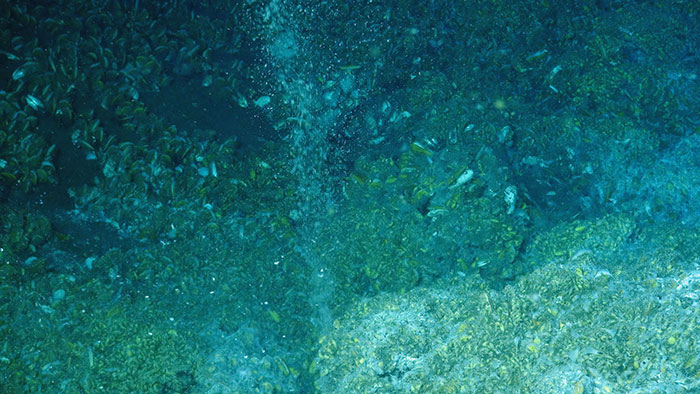

Methane gas bubbles rise from the seafloor – Image courtesy of Deepwater Canyons 2013 - Pathways to the Abyss, NOAA-OER/BOEM/USGS.
A natural gas storage well about 30 miles northwest of Los Angeles has leaked about 800,000 metric tons of greenhouse gases into the atmosphere, sickening local people and increasing California's emissions by about a quarter. While not visibly polluting like the Deepwater Horizon oil spill, it will take just as long - 3 months - to drill down to the 8,700-foot-deep leak and block it, and the owners are unable to estimate how much gas will have been released by then. This is bad news for the locals who have to be evacuated from their homes.
California is not the only area in the United States which is leaking methane. There have been leaks in New Mexico's San Juan Basin for years...

Natural gas is mostly methane, a naturally occurring greenhouse gas which makes up only a tiny fraction of the atmosphere, but contributes about 20% to global warming. It is given off by wetlands, forest fires, plants and animals from bacteria to termites to cows. The warmer it gets, the more methane is given off by plants such as rice paddies, and it is also released from entrapment in permafrost and ice. Humans add to the natural methane with the fossil fuel industry, landfills, waste water treatment facilities, and our increased burning of forests and raising of animals such as cows. While all these add gradually to the level of atmospheric methane, as recorded by Mauna Loa, there is an outside chance that if the planet warms enough that there will be a sudden irreversible release of methane hydrates or clathrates in the seas, leading to mass extinction. There are already signs that a warmer ocean may be releasing frozen methane

Methane is over 70 times more potent than carbon dioxide in the short term. Another difference is that it persists in the atmosphere for a shorter time than carbon dioxide, so cutting methane emissions has a faster effect than reducing carbon dioxide on reducing global warming, even though there is less of it in the atmosphere, so all sources should be reduced as soon as possible. As methane breaks down it forms carbon dioxide and other compounds. It takes hundreds of years before a release of one ton of methane has only the same effect as one ton of carbon dioxide released at the same time. This comparison is called the Global Warming Potential. So natural gas is not a good bridge fuel. Shale gas is also mostly methane. Animal agriculture produces about as much methane as the natural gas industry. Methane from cows has already been reduced by boosting milk-production efficiency, but the fossil fuel industry says additional methane regulations on oil and natural gas wells by the EPA are unnecessary.
Read more about the California methane leak, and how much natural gas is stored underground in your state, here.
Related...
Article: The Giant Methane Monster Lurking...
Site/movie: Last Hours (video narrated by Leonard DiCaprio)
Article: A Mysterious Hole at the End of the World
Transcript/video: Understanding Climate Change: A Conversation with Michael Mann - 10 November '15
Site/movie: Carbon (video narrated by Leonard DiCaprio)
Site/movie: Restoration (video narrated by Leonard DiCaprio)
Site/movie: Green World Rising (video narrated by Leonard DiCaprio)



